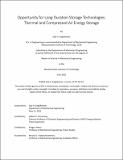Opportunity for Long Duration Storage Technologies: Thermal and Compressed Air Energy Storage
Author(s)
Engelkemier, Seiji H.
DownloadThesis PDF (4.797Mb)
Advisor
Armstrong, Robert C.
Terms of use
Metadata
Show full item recordAbstract
To mitigate more severe consequences of climate change, rapid decarbonization is necessary. The electric power sector contributes about 25% of US and global emissions, and its decarbonization is critical as other sectors become increasingly electrified. Intermittent renewable energy sources, namely solar photovoltaics and wind turbines have reduced emissions in the power sector. A key part in achieving higher rates of renewables adoption is energy storage. Particularly, long duration energy storage (LDES) is needed, for which the key variables are capital cost of energy capacity and discharge efficiency. There are few economical options available today for LDES aside from pumped hydropower storage, which is limited by geography. Fortunately, new technologies are under development.
Thermal energy storage (TES) is a promising class of technologies because energy can be stored cheaply as heat. A TES system converts electricity to heat and converts it back to electricity when needed. TES systems can utilize cheap storage material, but they must address the challenges of low discharge efficiency and to a lesser extent, high capital cost of discharge power capacity. Existing studies have mostly focused on a specific subsystem, such as the power block or storage material, or a single TES system. Few studies have reported on how the needs of future power systems and TES technology options guide the design choices for a TES system. This thesis addresses the topic and presents the opportunity space for TES systems. Three common strategies for system design are identified that balance the coupled tradeoffs of cost, performance, and technical risk. The first strategy is retrofitting thermal power plants with TES to replace combustion processes and operate the plants as storage assets. The second is the development of higher efficiency power cycles, primarily closed Brayton cycles, for new storage plants operating with maximum temperatures generally under 1000°C. The third strategy utilizes storage materials and power cycles at temperatures significantly above 1000°C which requires considerable research and development prior to commercialization efforts.
Compressed air energy storage (CAES) is another type of storage technology that is cited as a candidate for LDES. Geologic and economic considerations are found to be limiting factors in large scale deployment of CAES systems rather than technology development. However, in certain situations, CAES may be a valuable storage option. Therefore, compared to the optimism found in literature, a more pragmatic outlook on CAES is recommended to focus efforts on critical questions and avoid wasted resources.
The levelized cost of storage (LCOS) is used to assess future, representative TES and CAES systems in LDES applications. A sensitivity analysis is performed on LCOS parameters to show the effect of design choices on system cost. From the technology and cost assessments, recommendations are made to guide TES and CAES development as options for LDES.
Date issued
2023-06Department
Massachusetts Institute of Technology. Department of Mechanical EngineeringPublisher
Massachusetts Institute of Technology